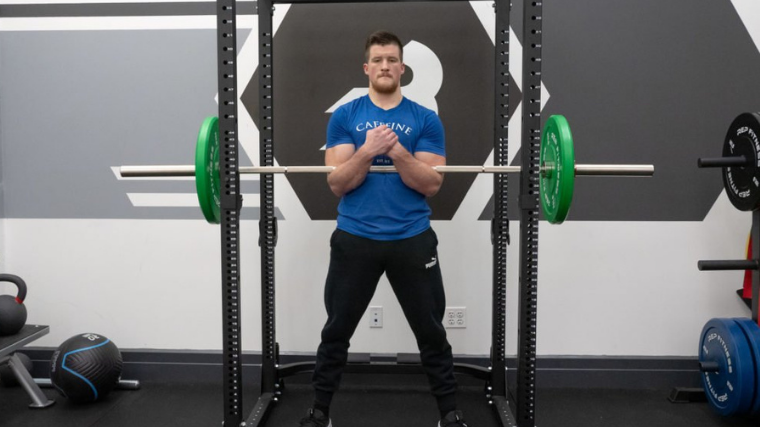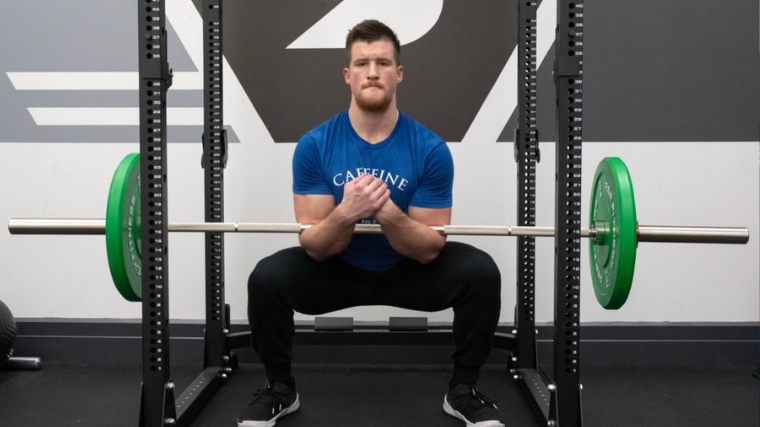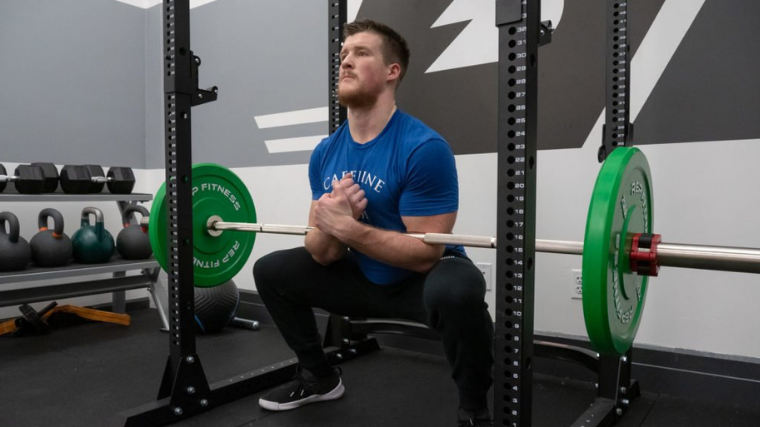Squatting is one of the most universally respected and commonly performed movements that have broad carry over to almost all athletic endeavors. Some variations, though, pose new challenges to even the most skilled lifter in the weight room. Enter the Zercher squat.
The Zercher squat differs drastically from standard barbell squats — the barbell is held in the crooks of the elbows instead of on the back or front rack. The adjustment in position challenges and strengthens the upper back, arms, and legs and is relevant for nearly every type of athlete.
In this article, we will go through everything you need to know about the Zercher squat so that you can safely perform this exercise, build serious functional strength and develop a better squat:
- How to Do the Zercher Squat
- Benefits of the Zercher Squat
- Muscles Worked by the Zercher Squat
- Who Should Do the Zercher Squat
- Sets, Reps, and Programming Recommendations
- Zercher Squat Variations
- Zercher Squat Alternatives
- Frequently Asked Questions
How to Do the Zercher Squat
The Zercher squat is a squat style that can build serious upper back strength, thoracic spine integrity, and increase quadriceps and glute development. Despite not having direct correlation to competitive lifts like the snatch or back squat, many athletes can benefit from the unique challenge that the Zercher squats place upon the body.
Below is a step-by-step guide on how to perform the Zercher squat with the barbell.
Step 1 — Scoop the Bar
Remove the barbell from a power rack by placing it in the crooks of the elbows and “scooping” it out. Set your feet in your normal squat stance, making sure to allow sufficient room for the elbows to reside inside the knees when you squat.
Coach’s Tip: You can clasp the hands together to add additional strength to the setup position.
Step 2 — Squat Low
With your torso upright, squat down as low as possible while trying to keep your hips directly underneath you. Avoid the elbows colliding with the knees or thighs.
Coach’s Tip: Be sure to resist the load as it attempts to pull your torso forwards.
Step 3 — Stand Up
Once you reach your full depth in the squat position, push hard through the floor as you would in a front squat. Pay extra attention to your trunk posture and “pull your chest up” with your arms to keep the torso upright.
Coach’s Tip: Tension should be felt in the legs, arms, shoulders, and core.
Benefits of the Zercher Squat
Carrying the barbell in your arms is more than just a means of making you tired during your set. Below are some benefits of the Zercher squat that you can expect when performing them for strength, muscle hypertrophy, and general fitness training.
Build Bigger, Stronger Quads
Increased quadriceps engagement and development is common in Zerchers due to higher degrees of knee flexion reached at the bottom of the squat (sometimes even more than the front squat).
[Read More: The Best Quad Exercises and Quad Workouts for Muscle Gain]
Since it targets the quads so well, the Zercher squat really benefits from being performed with slow, conscious control for each repetition to really maximize hypertrophic potential.
Train a More Upright Squat
When done correctly, this movement will force a very upright posture that also facilitates a high degree of knee flexion. The hips must also increase the range of motion due to a slightly wider stance. The Zercher squat is fantastic for training ideal overall squat form.
Develop Better Posture and Core Strength
Upper back and postural strength are stressed to the highest of degrees when the barbell is placed in front of the midline. If the core and upper back are not up to snuff for each repetition, the lift falls to pieces. The location of the barbell makes the Zercher squat ideal for reinforcing strong posture and steel-forged abdominals.
Muscles Worked by the Zercher Squat
Like any good squat, the Zercher involves a ton of musculature both in the upper and lower body. However, carrying the barbell in the arms adjusts where tension is placed and stimulates the tissues in a unique way. Below are the big muscular players in the Zercher squat.
Quadriceps
The Zercher squat requires that you squat low and in a vertical position. When you squat more vertically, you create greater amounts of knee flexion, which in turn increases the stretch and loading on the quadriceps when compared to a more hip dominant or even slightly less upright squat.
Glutes
The glutes, like in all squats, are engaged to greater degrees the deeper and lower you go on each repetition. The glutes work to assist the quads during the squat, both by adding stability in the deep squat and strength to stand up with power and intent.
Abdominals and Obliques
The further a load is away from the midline, the harder your muscles have to work to act on it. By front-loading the movement, the Zercher squat ramps up the intensity and demands on the abdominals and obliques as the lifter is required to develop greater amounts of anterior core stability to perform the squat.
Lats and Upper Back
By placing the load in the front of the body, the Zercher squat demands that you remain as upright as possible. The upper back and lat muscles work to keep your torso erect, while also assisting the biceps in securing the load in the elbows.
Biceps
The biceps are used primarily to support the load as it is held in the elbows. The Zercher squat forces the biceps to contract isometrically in order to keep the load fixed throughout the movement.
Who Should Do the Zercher Squat
The Zercher squat is a challenging squat variation that can be trained for strength, hypertrophy, or to improve positional awareness in the squat. Below is a more complete breakdown discussing how the Zercher can be beneficial for various populations.
Strength and Power Athletes
Strength and power athletes rely on high amounts of strength and muscle mass to perform in the gym. The Zercher squat can help improve positional awareness and develop the postural strength necessary for improving sport-specific demands.
Powerlifting and Strongman Athletes
Powerlifters can get a lot of value out of Zerchers as a squat accessory movement that trains core and upper back strength if they lack the mobility to perform front squats. For strongmen, the loading style of the Zercher squat mirrors a front-load carry, variations of which are common in strongman events.
Olympic Weightlifting
While the front squat obviously has far more direct relevance for Olympic lifters, some weightlifters might enjoy Zercher squats as a means of accomplishing some posture training in a new way or if working around a wrist injury.
Fitness and Everyday Athletes
This movement can be used by all athletes to increase upper back strength, core stability, and place a greater emphasis on the quadriceps if performed with proper posture.
This movement can also be highly beneficial to most individuals, regardless of sport, as front-loaded carrying and lifting of loads is highly functional to real-life training, manual labor, or contact sports.
[Read More: The Best Ab Exercises & Workouts, According to a CPT]
Additionally, the extremely vertical posture may reduce stress on the lumbar spine for those wary of stress on the back. The Zercher also allows for some real-world squat training even if you have serious restrictions at the shoulder or wrist joints.
Zercher Squat Sets, Reps, and Programming Recommendations
The Zercher squat is an exercise that can be trained for a wide variety of training outcomes. Note that the below guidelines are here to offer coaches and athletes loose recommendations for programming, and are not to be taken as gospel.
To Improve Squat Patterning
The Zercher squat can be done to increase squat performance and patterning with lifters who may otherwise have issues placing a barbell on their backs. Coaches can also include techniques like pauses and tempos to further enhance movement awareness in the squat.
Start by performing 3-4 sets of -8 repetitions with light to moderate loads, at a controlled speed (focusing on a proper eccentric), resting as needed.
To Increase Muscle
The Zercher squat, when programmed and performed well, can be a great all-around muscle builder. The unique loading parameters sneak some extra upper-body stimulus into a movement pattern that usually only benefits the legs.
Start by performing either 3-5 sets of 5 – 8 repetitions with moderate to heavy loads or 2-4 sets of 12-15 repetitions with moderate loads to near failure, keeping rest periods to no longer than 90 seconds.
To Gain Strength
The Zercher squat can be used to develop maximal strength potential for anyone who likes to push their limits in the gym. The Zercher squat is also susceptible to customization via intensity techniques or the addition of bands or chains as a form of accommodating resistance.
Start by performing 3-5 sets of 3-5 repetitions with heavy loading, resting as needed.
Zercher Squat Variations
The Zercher squat is an exercise that offers immense benefits to coaches and lifters alike. By adding in slight variations, you can prioritize strength, hypertrophy, or positional awareness to different extents based on your individual needs or the needs of your athletes.
Below are three common and effective Zercher squat variations to build strength, muscle mass, technique, and modify movement integrity.
Zercher Carry
In addition to the Zercher squat, Zercher carries and/or holds can be programmed to help reinforce upper body strength and posture strength. You can simply add this to the beginning (or end) of a squat session by either walking or holding the barbell for distance or time.
Front-Foot Elevated Zercher Split Squat
While it is a mouthful, this unilateral leg variation really crushes the quadriceps. By squatting to one leg at a time, the load is focused in more directly and weak points in both leg strength and core stability are easily identified. Adding an element of balance into the mix makes this move a Swiss army knife of training stimuli.
Tempo Zercher Squat
The tempo Zercher squat can be done to increase time under tension, improve movement patterning, and reinforce positional awareness and strength. By slowing down the tempo, you are also able to increase mechanical loading on the muscles with less load, which may be a great way to train hypertrophy and positions with lifters who may not be able to load up the plates.
Zercher Squat Alternatives
Zercher squats are a good alternative to front squats or as a standalone movement. However, some may find the Zercher squat painful on the arms or intimidating by nature, but still want to train in a way that mimics the movement.
While it is usually okay to work through some slight discomfort when first learning a new movement, there are some workable alternatives to the Zercher squat available.
Double Kettlebell Front Squat
Simply rack two kettlebells (or dumbbells) in the front position and perform in similar fashion. Due to the kettlebells being independent of one another, there is an extra element of challenge to your balance and proprioception.
Medicine Ball or Sandbag Squat
If you don’t have access to a barbell, holding a medicine ball in front of your body will mimic the loading style of a Zercher squat while also being far less uncomfortable on the elbows. In fact, any moderately-sized implement — or tiny human being — works as a suitable form of resistance here.
[Related: The Essential Sandbag Workout For Strength Athletes]
Front Squat
There’s no shame in going back to the source if Zercher squats aren’t your cup of tea. The front squat comes with its own package of perks and is a fantastic way to stimulate many of the muscles and actions as the Zercher squat.
Final Word
The Zercher squat is not just a lower body exercise. For many lifters, poor back strength and postural awareness can leave them less tall and proud and more hunched over like a turtle shell.
The Zercher squat, aside from being a good movement to gain strength in the quads and hips, can also target the muscles and movements needed to stay upright in front and back squats.
While the movement can be applied to most forms of training, context is highly important. A potent but niche exercise like the Zercher squat requires precise integration and a steady hand behind the wheel in terms of programming, but the results will be well worth it.
Frequently Asked Questions
The Zercher squat is a pretty unique and challenging movement, and therefore there are a ton of questions about it. Let’s take a look at some of the big concerns and address them.
This is common, and is unfortunately part and parcel for the exercise to a degree. If you don’t have bulging biceps or are new to the movement, a long-sleeved shirt or even a pair of elbow sleeves should help do the trick. A thicker barbell may also lessen any painful sensations. This could be a patterning issue, or a strength issue, or both. First, make sure you are squatting down so that your hips are staying underneath you, rather than actively pushing them backwards. You can elevate your heels if needed as well, which will help you push your knees forward more in the squat, creating better leverage.Zercher squats really hurt my arms. What can I do?
How do I keep my hips in place during the movement to avoid tipping forward?


